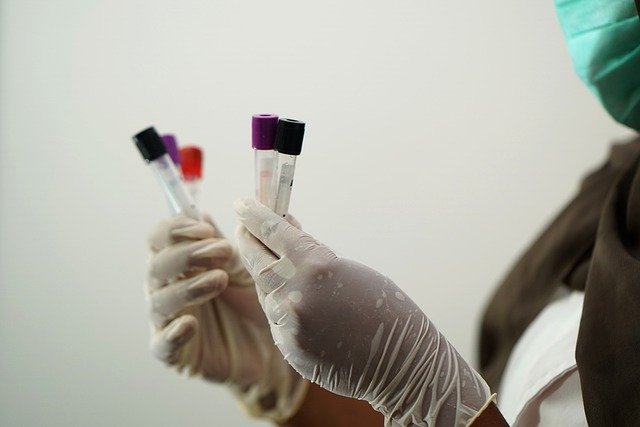26 tumor markers and their clinical significance
- Early Biomarker for Multiple Sclerosis Development Identified Years in Advance
- Aspirin Found Ineffective in Improving Recurrence Risk or Survival Rate of Breast Cancer Patients
- Child Products from Aliexpess and Temu Contain Carcinogens 3026x Over Limit
- Daiichi Sankyo/AstraZeneca’s Enhertu Shows Positive Results in Phase III DESTINY-Breast06 Clinical Trial
- Mn007 Molecules Offer Potential for Combating Streptococcus pyogenes Infection
- Popular Indian Spices Banned in Hong Kong Over Carcinogen Concerns
26 tumor markers and their clinical significance
- AstraZeneca Admits for the First Time that its COVID Vaccine Has Blood Clot Side Effects
- Was COVID virus leaked from the Chinese WIV lab?
- HIV Cure Research: New Study Links Viral DNA Levels to Spontaneous Control
- FDA has mandated a top-level black box warning for all marketed CAR-T therapies
- Can people with high blood pressure eat peanuts?
- What is the difference between dopamine and dobutamine?
- How long can the patient live after heart stent surgery?
26 tumor markers and their clinical significance, this article will help you sum up!
Tumor marker (TM) monitoring and dynamic assessment are must-check items for cancer patients after each admission, and mastering specific markers of different tumors is one of the necessary skills for cancer clinicians.
Therefore, the author summarizes the common clinical tumor markers , hoping to be helpful to everyone.

Thyroid Cancer TM
Thyroid cancer tumor marker detection: including thyroglobulin (thyroglobulin, Tg), calcitonin and carcinoembryonic antigen (CEA) .
Tg is a specific protein produced by the thyroid gland, but the determination of serum Tg lacks specific value in differentiating benign from malignant thyroid nodules. Therefore, serum Tg determination is generally not used in the preoperative diagnosis of DTC clinically.
In the follow-up phase of DTC patients after treatment, the change of serum Tg is an important means to judge whether the patients have tumor recurrence, and serum Tg can be used to monitor the recurrence and metastasis of DTC.
Serum Tg measurement in DTC follow-up includes basal Tg measurement (TSH suppressed state) and Tg measurement after TSH stimulation (TSH>30mU/L).
In order to reflect the condition more accurately, stop using L-T4 or apply recombinant human thyrotropin (rhTSH) to increase the serum TSH level to >30mU/L, and then perform Tg detection, that is, Tg determination after TSH stimulation.
Tg levels measured after L-T4 withdrawal and rhTSH administration were highly consistent. For DTC patients whose recurrence risk is stratified as intermediate or high risk, Tg after TSH stimulation can be detected if necessary. It should be noted that Tg should be detected simultaneously with TgAb.
Esophageal Cancer TM
At present, there is a lack of specific blood tumor markers for esophageal cancer , such as circulating tumor cells, circulating tumor DNA/RNA, epigenetic markers (DNA methylation, non-coding RNA, histone modifications, etc.), exosomes, etc.
In the laboratory or preclinical research stage, routine clinical diagnosis and treatment are not recommended unless within the scope of clinical research.
Lung cancer TM
At present, the commonly used primary lung cancer markers recommended by the American Committee of Clinical Biochemistry and the European Tumor Marker Expert Group include carcinoembryonic antigen (CEA), neuron-specific enolase (NSE), and cytokeratin 19 fragment (CYFRA21-1). and progastrin-releasing peptide (proGRP), and squamous cell carcinoma antigen (SCC-Ag).
The level of CEA in the serum of patients with lung cancer was significantly increased, most notably in adenocarcinoma.
Serum CYFRA21-1 in patients with lung cancer was significantly elevated, especially for squamous cell carcinoma of the lung with high sensitivity and specificity.
The concentration of serum SCC-Ag is related to the degree of differentiation and clinical stage of SCC.
Serum NSE levels in patients with SCLC were significantly higher, while the levels of NSE in patients with adenocarcinoma and squamous cell carcinoma were similar, both of which were significantly lower than those in SCLC, so NSE has a good differential diagnosis value.
Serum ProGRP in patients with lung cancer is significantly higher, has higher sensitivity and specificity for SCLC, and increases with the progress of clinical stage, so it is widely used in auxiliary diagnosis, curative effect monitoring and prognosis evaluation of SCLC.
Suggestions for the combined application of different tumor markers in lung cancer:
- SCLC (small cell lung cancer):
The combined detection of ProGRP + NSE has a high diagnostic value for SCLC.
- NSCLC (non-small cell lung cancer):
The dual detection of SCC-Ag + CYFRA21-1 has a high diagnostic value for squamous cell carcinoma of the lung;
CEA + CYFRA21-1 dual detection has a high diagnostic value for NSCLC, especially lung adenocarcinoma.
Breast cancer TM
The National Health Commission’s “Guidelines for Diagnosis and Treatment of Breast Cancer (2022 Edition)” only regards CA15-3 and carcinoembryonic antigen (CEA) as tumor markers with high application value in breast cancer.
C A1 5-3 is a breast cancer-associated antigen, which was first discovered in breast cancer cells and is a serum tumor marker with high specificity in the diagnosis of breast cancer.
Current evidence is insufficient to prove that CA15-3 is suitable for screening and early diagnosis of breast cancer.
Although not very helpful in early breast cancer, in advanced breast cancer, the sensitivity of CA15-3 can reach 70%.
The sensitivity and specificity of CEA for breast cancer were 45.8% and 96.7%, respectively.
CA15-3 and CEA lack specificity and sensitivity for early prevention and diagnosis of breast cancer. Clinically, the two are often used together or combined with other markers to monitor breast cancer.
Stomach cancer TM
It is recommended that CA72-4, carcinoembryonic antigen (CEA) and CA19-9 be routinely recommended , and alpha-fetoprotein (AFP) and CA125 can be further detected in some patients.
CA125 has certain effects on peritoneal metastasis and AFP on special pathological types of gastric cancer. diagnostic and prognostic value.
The sensitivity and specificity of CA242 and tumor-specific growth factors, pepsinogen (PG) Ⅰ and PG Ⅱ have yet to be recognized.
Hepatocellular Carcinoma (HCC) TM
At present, serological markers commonly used in clinical detection and auxiliary diagnosis of HCC include alpha-fetoprotein (AFP) , alpha-fetoprotein variant (AFP-L3), abnormal prothrombin (DCP) and so on. Among them, AFP is the most commonly used marker in the auxiliary diagnosis and curative effect monitoring of HCC.
The normal value of AFP is 0 – 8.1 ng/mL. In the case of excluding active liver disease, germinal embryonoma and pregnancy, serum quantitative measurement of AFP > 400 ng/mL for four weeks, or > 200 ng/mL for eight weeks, can be diagnosed as primary liver cancer.
Cholangiocarcinoma TM
CA19-9 and CEA are the most commonly used serum markers for diagnosing ICC, which have the value of diagnosis and prediction of curative effect . Others can be combined with CA242 and CA125 for auxiliary diagnosis.
Pancreatic Cancer TM
Commonly used clinical tumor markers related to the diagnosis of pancreatic cancer include CA19-9, carcinoembryonic antigen (CEA), carbohydrate antigen 125 (CA125), etc., among which CA19-9 is the tumor marker with the highest application value in pancreatic cancer, available It is used for auxiliary diagnosis, curative effect monitoring and recurrence monitoring.
CA242 is a relatively new pancreatic cancer biomarker that can aid in the management of pancreatic cancer therapy.
Renal cell carcinoma (RCC) TM
There is no recognized serum tumor marker for the early diagnosis of renal cell carcinoma.
Colorectal Cancer TM
CEA, CA242, and CA19-9 are more sensitive. Patients with liver metastases are recommended to detect alpha-fetoprotein (AFP); Patients with ovarian metastases are recommended to detect CA125.
Prostate Cancer TM
PSA (Prostate Cancer Specific Antigen) is organ-specific and significantly increases the detection rate of prostate cancer in the early, asymptomatic and curable stages.
PSA includes total PSA (T-PSA) and free PSA (F-PSA). F-PSA and T-PSA can be combined detection, when F-PSA /T-PSA <0.16, may suggest prostate cancer.
Bladder Cancer TM
Urine NMP22 (lineage matrix protein) detection to identify benign and malignant bladder diseases, in addition to bladder tumor antigen-related (BTAstat and BTAtrak), immune-cell examination, fibrinogen degradation products and urine fluorescence in situ hybridization (fluorescenceinsituhybridization, FISH) wait.
Ovarian Cancer TMT
Serum CA125 and human epididymis protein 4 ( humanepididymisprotein4, HE4 ) are tumor markers with the highest application value in ovarian epithelial cancer, which can be used for auxiliary diagnosis, curative effect monitoring and recurrence monitoring.
CA125 is the most commonly used ovarian cancer tumor marker, especially the preferred tumor marker for serous carcinoma. The positive rate of CA125 is related to tumor stage and histological type.
The positive rate of patients with advanced and serous cancer is significantly higher than that of patients with early and non-serous cancer (the positive rate of early ovarian cancer is about 43.5%-65.7%, and the positive rate of advanced ovarian cancer is about 43.5%-65.7%. The positive rate is about 84.1% to 92.4%).
HE4 is a tumor marker that has been clinically used for more than 10 years, and its diagnostic specificity for ovarian cancer (about 90%-95%) is higher than that of CA125 (76.6%-86.5%).
HE4 level is not affected by menstrual cycle and menopausal status. In premenopausal population, its specificity (88.4%-96.8%) for diagnosing ovarian cancer is better than that of CA125 (63.3%-85.7%).
For epithelial cancer, CA125, CA19-9, CEA, etc. are most commonly used. For yolk sac tumor, pay attention to re-examination of AFP, and for dysgerminoma, re-examination of LDH.
Cervical Cancer TM
Squamous cell carcinoma-associated antigen (SCC) is an important marker of cervical squamous cell carcinoma, and a serum SCC-associated antigen level exceeding 1.5ng/ml is considered abnormal.
Because squamous cell carcinoma is the most common type of cervical cancer, SCC is the most commonly detected serological tumor marker in the diagnosis and treatment of cervical cancer.
Cervical adenocarcinoma may have elevated carcinoembryonic antigen (CEA), CA125, or CA19-9.
Endometrial Cancer TM
There are no specific sensitive markers for endometrial cancer. Abnormalities of CA125 or CA19-9, CA153 or HE4 may appear in some patients , which are correlated with histological type, depth of myometrial invasion, extrauterine invasion and other factors, and have certain reference value for disease diagnosis and postoperative condition monitoring.
26 tumor markers and their clinical significance
(source:internet, reference only)
Disclaimer of medicaltrend.org
Important Note: The information provided is for informational purposes only and should not be considered as medical advice.



